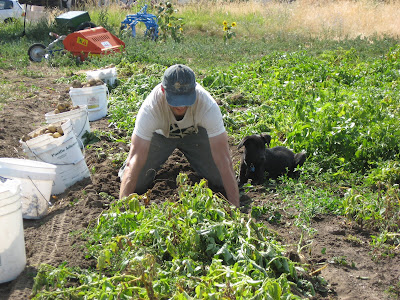Many folks visit our booth at the Farmer’s Market and remark, “Oh, I drive by your farm all the time!” It makes me wonder…what do these people think when they see us out in the fields doing our various tasks that all add up to farming? One of the weirdest sights must be when we swim for potatoes.

To harvest a small batch of potatoes, all you need is a pitchfork to loosen up a plant or two. But when we harvest for the CSA or market, we pull up dozens of plants at a time. And a pitchfork is too slow. To dig up part of a row, a lifting blade is attached to the back of the tractor. We drag the blade through the row and it undercuts and lifts the plant and potatoes up near the surface of the soil. Now, in a perfect world, the potatoes would fall neatly into a little pile and we’d collect them in no time at all. But this is farming, and “perfection” comes around once and a while, but with potatoes we’ve still got to do some work. So we go swimming.
Here’s where the folks driving by might do a double-take. To swim for potatoes we get down on our knees in the lifted row, and using our arms like fins we do a modified butterfly stroke, scooping soil, plant, and potatoes towards our body. At this point it’s basically an Easter egg hunt. The potatoes usually sift above the soil, plant top is tossed over the shoulder (after, of course, removing any hanger-on potatoes that might become next year’s weeds), and the gathered potatoes go into a bucket. Then we move forward a scootch and repeat the stroke. It’s a great workout! The damp, warm soil moves smooth against the skin. Black beetles (beneficial insects) are unearthed and moved into the next row over. Now and then you find blue potatoes in the yellow section, a result of the helpful five year-olds that assisted in planting this row. Before you know it, you’ve reached the tractor, and you’ve got four buckets full of spuds. We’ve been pulling out German butterball and All-blue varieties, but keep your eyes out for new varities soon! (It’s funny; we labeled the rows with stakes when we planted, but those stakes have either disappeared or been sun-bleached. Thankfully Jim is able to identify any potato in the world.)
Intern’s Insight #2: Swimming for Potatoes
post by: Debbie Fields August 10, 2009






